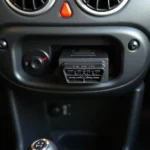Car diagnostic tool OBD2 has revolutionized vehicle diagnostics, empowering car owners and mechanics alike to pinpoint issues with unprecedented ease. Gone are the days of relying solely on guesswork and expensive trips to the mechanic. With an OBD2 scanner, you can unlock a wealth of information about your vehicle’s health, making maintenance a breeze and saving you potentially costly repairs down the line.
Understanding OBD2 and Its Significance
OBD2, short for On-Board Diagnostics, is a standardized system implemented in vehicles since 1996 in the United States (1994 for some manufacturers) and 2001 in Europe. It acts as your car’s central nervous system, continuously monitoring various systems and components for malfunctions. When an issue arises, the OBD2 system stores a corresponding Diagnostic Trouble Code (DTC) in the vehicle’s computer.
This is where car diagnostic tools OBD2 come into play. By plugging into the OBD2 port, typically located under the dashboard on the driver’s side, these tools can retrieve and interpret those stored DTCs. This provides invaluable insights into the nature of the problem, allowing you to:
- Identify the root cause of warning lights on your dashboard, such as the check engine light.
- Access real-time data from your vehicle’s sensors, including engine RPM, coolant temperature, oxygen sensor readings, and more.
- Monitor fuel efficiency and identify potential areas for improvement.
- Perform basic maintenance tasks, such as resetting the oil light after an oil change.
Choosing the Right Car Diagnostic Tool OBD2
With a plethora of car diagnostic tools OBD2 available, selecting the most suitable one can seem daunting. Consider these factors:
- Functionality: Basic OBD2 scanners read and clear DTCs, while more advanced models offer live data streaming, graphing capabilities, and even specific manufacturer codes. Determine your needs and budget accordingly.
- Compatibility: Ensure the scanner you choose is compatible with your vehicle’s make, model, and year. Most modern scanners support a wide range of vehicles, but it’s crucial to double-check.
- User Interface: Opt for a scanner with an intuitive interface and easy-to-understand menus. Some scanners feature color displays, touchscreens, and multilingual support for added convenience.
- Connectivity: Consider whether you prefer a wired connection or the flexibility of a wireless Bluetooth OBD2 scanner that connects to your smartphone or tablet.
Benefits of Using a Car Diagnostic Tool OBD2
Investing in a car diagnostic tool OBD2 offers a multitude of benefits:
- Save Time and Money: By identifying problems early on, you can avoid costly repairs and unnecessary trips to the mechanic.
- Gain Peace of Mind: Knowing you have a tool to diagnose car troubles can provide peace of mind, especially on long trips or in emergency situations.
- Empower Yourself: Take control of your car maintenance by understanding the issues yourself and making informed decisions about repairs.
Common Uses for Car Diagnostic Tools OBD2
Car diagnostic tools OBD2 prove invaluable in various scenarios:
- Diagnosing Check Engine Light: Easily decipher the reason behind that pesky check engine light and determine the necessary course of action.
- Monitoring Engine Performance: Track parameters such as RPM, temperature, and oxygen sensor readings to assess engine health and identify potential issues.
- Analyzing Emissions Data: Ensure your vehicle complies with emission standards by checking oxygen sensor readings and catalytic converter efficiency.
- Troubleshooting ABS and Airbag Systems: Some advanced scanners can access and diagnose issues within the Anti-lock Braking System (ABS) and airbag control modules.
Beyond Basic Diagnostics: Advanced Features
High-end car diagnostic tools OBD2 offer advanced features for professional mechanics and experienced DIYers:
- Bi-directional Control: Allows you to interact with vehicle systems, such as activating solenoids or running specific tests, to pinpoint issues more efficiently.
- Programming and Coding: Facilitates tasks like key fob programming, injector coding, and module resets, often requiring specialized software.
- ECU Flashing: Involves updating the vehicle’s Engine Control Unit (ECU) with new software, typically performed by experienced technicians.
Conclusion
A car diagnostic tool OBD2 has become an essential tool for car owners and mechanics alike. From understanding warning lights to accessing real-time vehicle data, these devices provide invaluable insights into your car’s health. Whether you’re a seasoned mechanic or a car enthusiast looking to take control of your vehicle’s maintenance, investing in the right car diagnostic tool OBD2 empowers you to diagnose issues accurately and confidently.


